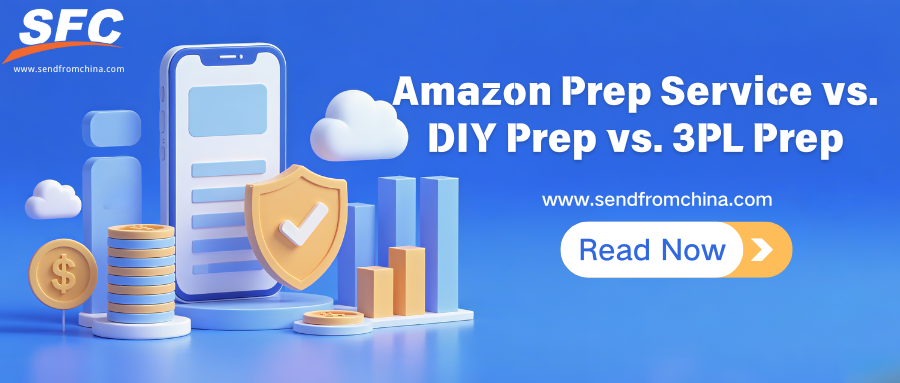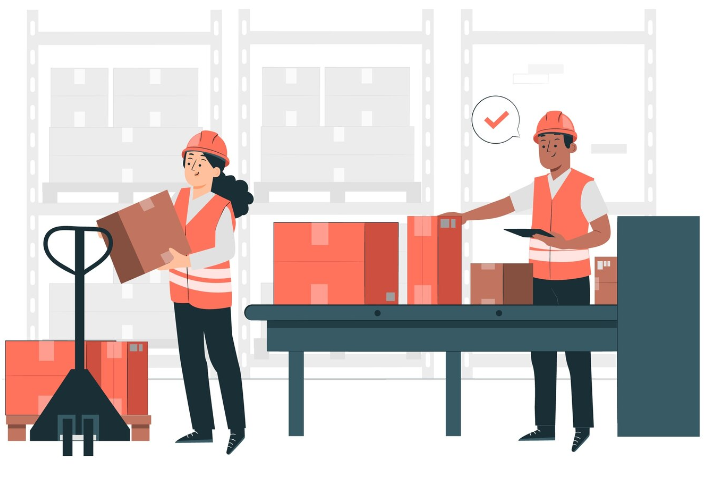Table of Contents
Amazon Prep Service vs. DIY Prep vs. 3PL Prep: Which Is More Cost‑Effective?
Time: Aug 07,2025 Author: SFC Source: www.sendfromchina.com
As an Amazon seller, deciding how to prepare your inventory—whether via Amazon’s own prep service, doing it yourself (DIY), or outsourcing to a third‑party logistics (3PL) provider—can significantly impact both your financials and your operations. In this article, we’ll break down the cost components, share real seller feedback, and show why SendFromChina stands out among 3PL prep centers based in China.
1. Understanding the Prep Serivce Options for Amazon Sellers
When you’re launching or scaling on Amazon, how you prepare your inventory is a strategic choice. Choosing among Amazon’s internal prep service, DIY (Do-It-Yourself) prep, or a third-party logistics prep partner is more than a cost decision—it influences quality, control, compliance, and ultimately your brand reputation.Amazon’s FBA Prep Service (Amazon Prep)
Amazon offers sellers an optional in-house prep service that handles labeling, poly-bagging, bubble-wrapping, bundle packaging, and more before items enter FBA. It’s undeniably convenient: you ship your inventory to Amazon, and they take it from there. That includes compliance checks, packaging, shipping to FBA warehouses, and even returns and customer service.It’s great for sellers who want minimal logistics headaches, and Prime eligibility comes built‑in. But that convenience comes at a premium. Amazon’s unit fees—often ranging from $0.40–$1.50 per service action, plus fulfillment/handling charges—can add up, especially on low-margin or bulky items.
DIY Prep (In-House)
DIY prep gives you full control—your team handles everything: labeling, packaging, compliance, inspection, bundling, and shipping. Early on, when you’re testing products or handling small batches, it can feel like the lowest-cost route. No per-unit prep fees, just raw material and labor costs.But there’s a tipping point. As volume grows:
- Labor—and therefore hidden costs—mounts.
- Errors become more frequent.
- Warehouse space, equipment, and inventory management become significant overhead.
Plus, if you mislabel or fail to meet Amazon standards, you risk delays, rejects, and penalties.
DIY may suit micro‑scale operations or product development phases, but its scalability is limited.
3PL Prep Service (Third-Party Logistics)
A 3PL partner—such as SendFromChina—handles prep tasks like labeling, quality inspection, bundling, packaging, plus shipping to FBA or other channels. Many sellers opt for 3PLs when scaling or when they need flexibility, brand control, or multi-channel logistics.These partners often offer:
- Custom packaging, branding inserts, kitting.
- Inspection protocols to catch defects before products go to Amazon.
- Transparent, tiered pricing for services.
- Scalability and seasonal flexibility.
Notably, while Amazon prep is only for Amazon fulfillment, 3PLs likely support multi-channel fulfillment (Shopify, Walmart, direct-to-consumer), giving you greater flexibility.
2. FBA Prep Service Cost Components
When evaluating prep options—Amazon, DIY, or 3PL—it pays to understand how costs truly stack up. Beyond headline unit fees lie layers of labor, materials, volume pricing, and hidden charges.
Amazon FBA Prep Service Fees
Amazon charges per unit for each prep task and categorizes items as standard-size or oversized. Common rates as of 2025 include:- Labeling (FNSKU/barcode): ~$0.30 per unit for both standard and oversized items
- Polybagging: ~$0.80 for standard-size; ~$1.50 for oversized items
- Bubble wrap: ~$0.80 standard; ~$1.50 for oversized
- Taping and shrink wrap: ~$0.40–$0.60 depending on item size
If multiple prep tasks are required (e.g. labeling + polybagging + bubble wrap), fees add up. For example, a fragile, oversized item needing all three prep steps may cost $2.60+ per unit in Amazon fees alone.
If sellers fail to prep items properly according to Amazon’s guidelines, unplanned prep fees or penalties apply at these same rates—sometimes even higher—and inventory may be delayed or rejected.
DIY Prep – Hidden Costs Behind Perceived “Free”
On the surface, DIY prep avoids Amazon’s per-unit fees—but there are real costs to consider:- Labor time and opportunity cost: The hours your team spends on prep—labeling, polybagging, packing—distracts from strategic activities like sourcing, marketing, or launching new SKUs. This unseen cost can be significant.
- Materials and equipment: You need label printers, polybags, bubble wrap, packing tape, tables, shelving, and possibly automatic sealers or label applicators—especially if volume increases. These infrastructure costs scale quickly.
- Error and compliance risk: If labels are misprinted, barcodes unscannable, or packaging doesn’t meet standards, Amazon may charge unplanned prep or delay shipments—undoing any perceived savings.
3PL Prep Service Cost Components
While not Amazon’s internal prep, many third-party prep centers offer clear, tiered pricing and bundled services. Typical industry cost breakdown includes:- Basic prep (receiving + inspection + labeling): Often ranges $0.20–$0.60 per unit depending on volume and complexity.
- Additional prep services (charged per unit or order):
- Labeling: $0.10–$0.50 per unit
- Polybagging: $0.20–$1.00 per unit
- Bubble wrap: $0.35–$1.00 per unit
- Bundling or kitting: $0.90–$1.60 per unit or bundle
- Marketing inserts or extras: $0.70–$1.00 per insert.
- Pick & Pack for other channels: $0.50–$2.00 per unit plus $1–$5 per order, depending on standard vs oversized items.
- Storage fees: Often charged per pallet ($30–$40/month) or per cubic foot ($0.50–$1.00), with free short-term storage (15 days or more) included in some plans.
- Inbound receiving / pallet handling: $6–$40 per pallet, or $10–$500 per container unload depending on size.
- Volume discounts and bundling: Larger monthly volume often reduces per-unit cost significantly. Providers may quote $0.40 per unit or less at high volumes (>1,000 units) with bundled prep included.
3. Real‑World Seller Voices
From Reddit forums, sellers share real data:“Personally, I wouldn’t use the service as I think it’s far too expensive for what it is… to label 2,000 units would cost about £300”.
“We ship around 8,000 units a week … the cost of this at a prep center or Amazon would be tremendous.”
These voices underscore the reality: volume heavily influences cost-effectiveness.
4. When to Choose: Amazon Prep vs DIY vs 3PL Prep
Deciding which prep route to take isn't just about unit cost—it hinges on your volume, product complexity, growth stage, control needs, and longer‑term strategy.
When DIY Prep Works Best
Use DIY when:- You’re testing product ideas or handling low volume (e.g. less than 50–100 units/month).
- You need full control over packaging, branding, and workflow.
- You have spare warehouse space and labor capacity.
- You value the learning curve and want firsthand familiarity with Amazon compliance.
As one experienced seller noted on Reddit:
“As a beginner, it's often best to start handling your own prep work. This way, you learn the ins and outs of the process… You'll make mistakes, but that's part of the learning curve.”
DIY gives complete flexibility, but the moment order volume increases or SKUs multiply, inefficiencies mount—labor hours increase, errors creep in, and opportunity cost grows.
When Amazon Prep Service Can Be Suitable
Consider Amazon’s internal prep if:- Your order volume is small, or you prefer hands-off logistics.
- You don’t require custom packaging or branding inserts.
- You’re comfortable with Amazon’s standard box/process and want Prime-ready listings without additional systems.
However, there are caveats:
- Amazon is phasing out all internal prep services by January 1, 2026, meaning labeling, bagging, kitting, and bubble-wrap services must be handled externally after that date.
- Amazon’s prep involves limited communication or customization and minimal transparency if prep errors occur—they may charge you post-factum and deliver the financial hit back to your account with little recourse.
Amazon’s prep is straightforward but rigid—good for sellers with very simple needs but with diminishing relevance soon.
When 3PL Prep Services Shine
A 3PL partner—especially one experienced in Amazon prep—is the preferred option when:- You're managing growing volume or multiple SKUs, especially bundles or fragile products.
- You want quality control, inspection, item-level verification, and fewer errors.
- You sell through multiple channels (Amazon, Shopify, Walmart, DTC) and need consolidated fulfillment.
- You want custom packaging, inserts, or kitting services.
- You value scalability without investing in warehousing infrastructure or labor.
Real sellers frequently turn to prep centers for years of consistency:
“Man they are incredible. $0.99 prep fee. Polybag, bubble wrap, FNSKU and parcel label photo… I definitely recommend it.”
And experienced sellers often emphasize the peace of mind:
“3PL will generally be 0‑15% more expensive if… but if the time saved … allows you to generate more profit… then it makes sense.”
5. Non‑Financial Factors to Weigh: Amazon Prep vs DIY vs 3PL Prep
While cost plays a big part in choosing a prep strategy, many non‑monetary factors often prove more impactful as your business evolves. These include control, flexibility, customer experience, risk mitigation, and strategic growth. Let’s break it down.
Compliance, Quality & Error Risk
- DIY Prep offers maximum control over how inventory is checked, packaged, and labeled—but without 100% process discipline, mis‑labeled or non‑compliant units risk getting rejected or penalized by Amazon.- Amazon Prep eases this burden but limits visibility. If mistakes happen—like unscannable barcode or poor packaging—the financial fallout still lands on you, and often with little recourse.
- 3PLs, armed with prep SOPs, item‑level inspection, and sometimes photographic verification, reduce error risk while keeping you informed throughout the workflow.
Branding, Packaging & Customer Experience
- With DIY, you control every branding touchpoint—from custom inserts to branded wrapping.- Amazon provides only basic packaging—standard FBA boxes with minimal customization.
- 3PLs strike a middle ground: many offer branded packaging options, inserts, seasonal value-adds, and custom unboxing experiences tailored to your brand identity.
Strategic Agility & Multi‑Channel Flexibility
- DIY ties up your resources and limits your ability to pivot quickly across multiple sales channels.- Amazon Prep locks you into Amazon‑only logistics.
- 3PLs often integrate with Shopify, Walmart, Etsy, and DTC channels, helping you scale omni‑channel fulfillment strategy without reinventing workflows or systems.
Scalability & Seasonal Resilience
- DIY becomes a bottleneck quickly—you need more staff, space, and coordination as sales scale.- Amazon Prep can delay shipments during peak demand and enforce rising storage limits.
- 3PLs offer on-demand labor, flexible storage allocation, and agile handling of sales spikes across seasons or product launches.
Transparency, Communication & Support
- With DIY, you're deeply involved—but when trouble arises, every issue is your responsibility.- Amazon Prep offers limited seller support and no personalized account management.
- 3PLs frequently assign a dedicated account manager, offer SLAs, and provide real-time updates. But watch out—poor communication, hidden fees, or integration issues can still emerge in some providers.
Location & Logistics Footprint
- DIY usually means working off your own facility—often near suppliers or in your home market.- Amazon Prep relies on their fixed warehouse network within Amazon’s ecosystem.
- 3PLs with multiple distribution centers—ideally close to your core markets—can reduce lead times, cut shipping costs, and ensure faster delivery. If you're sourcing in China, a local 3PL like SendFromChina can reduce transit leg risk and sync prep with international fulfillment routing.
Risk Mitigation & Inventory Resilience
- DIY exposes you to operational risks—employee absences, errors, theft, or equipment downtime.- Amazon Prep centralizes risk—if Amazon has technical or warehouse issues, your inventory may be delayed.
- 3PLs can insulate you from Amazon-specific disruptions. If you lose access to Amazon (e.g., account holds), your multi-channel inventory remains under your control elsewhere.
Control vs Delegation Trade-Off
- DIY puts all operations in your hands—both a plus and a burden.- Amazon Prep hands everything over, except total transparency.
- 3PLs offer a balance—delegated logistics alongside visibility and collaboration, though you relinquish some direct control.
6. What Makes SendFromChina a Good FBA Prep Center
At SendFromChina, we bridge Chinese factories and global Amazon fulfillment smoothly—with specialized prep services including:- QC inspection, labeling, bubble‑wrapping, bundling, and FBA labeling compliant with every Amazon marketplace requirement.
- Competitive pricing from China labor costs—typically 25–50 % below Western third‑parties at volume.
- Seamless forwarder integration and customs handling for FOB or DDP shipments.
- Flexible no‑lock‑in contracts and scalable staffing, avoiding lengthy fixed commitments that some prep services impose.
By integrating prep before export, SendFromChina reduces unnecessary shipping weight, boxing cost, and Amazon inbound charges—delivering a combined cost advantage.
7. Conclusion
In the Amazon prep landscape, cost‑effectiveness is not just about the lowest apparent price per unit. While DIY may seem cheapest initially and Amazon’s prep offers simplicity, both fall short once volume, compliance, and scale become critical. A third‑party 3PL prep service—especially one like SendFromChina built to bridge China sourcing and global Amazon fulfillment—often offers the best blend of lower per‑unit cost, quality control, scalability, and strategic flexibility.For sellers with growing volume, complex SKUs, branding needs, or China‑based supply chains, partnering with a reliable 3PL prep center like SendFromChina can turn logistics from a friction point into a growth lever.
8. FAQs
1. Is Amazon’s prep service always more expensive than DIY?
Not always—but once you factor in error risk and lack of inspection, true cost often exceeds surface fees.2. At what volume should I consider a 3PL?
If you spend more than 5–10 hours/week prepping, or exceed a few hundred units/month, a 3PL becomes economically viable.3. Can I use SendFromChina if I'm not based in China?
Yes—SFC accepts goods from your Chinese suppliers and fulfills global Amazon FBA shipments on your behalf.4. Are there minimum order requirements with SendFromChina?
No rigid monthly minimums—SendFromChina supports both small and large shipments, scaling with your volume.5. How do I compare total costs across options?
Include per‑unit fees (Amazon or 3PL), labor value (DIY), packaging materials, warehousing overhead, error/rework costs, and opportunity cost of lost strategic work. Post Views:1018
Post Views:1018
Copyright statement: The copyright of this article belongs to the original author. Please indicate the source for reprinting.
Previous Post
Pros and Cons of Amazon: Is it Still Worth Selling on Amazon in 2026?
Next Post
Ultimate Guide to Warehouse Operations: Processes, Workflows & Resources
TAGS
Hot Research
Get a Custom China Fulfillment Solution with FREE Storage for 30 Days
 Want to know about our services, fees or receive a custom quote?
Want to know about our services, fees or receive a custom quote?
 Please fill out the form on the right and we will get back to you within a business day.
Please fill out the form on the right and we will get back to you within a business day.
 The more information you provide, the better our initial response
will be.
The more information you provide, the better our initial response
will be.





 TAGS:
TAGS: